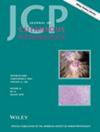Cutaneous Acanthamoebiasis: Two Cases Highlighting Diverse Histopathologic Findings
Abstract
Acanthamoeba is a free-living ameba, known to most commonly cause amebic keratitis in contact lens users and granulomatous amebic encephalitis in immunocompromised patients. Cutaneous Acanthamoebiasis as a single-organ manifestation is less common. We report two cases seen in our department. Case one is a 23-year-old hospitalized patient with systemic lupus erythematosus and pancytopenia who acutely developed nodules on the extremities. Biopsy showed lymphohistiocytic inflammation and focal coagulative necrosis in the subcutaneous fat. Acanthamoeba trophozoites and cysts were apparent in H&E-stained sections and highlighted by PAS and GMS stains. PCR studies were positive for Acanthamoeba species. Case two is an 81-year-old with diffuse large B-cell lymphoma on idelalisib, who presented with a three-week history of ulcerating nodules on the extremities. Biopsy from the left arm exhibited a mixed deep dermal infiltrate with neutrophils and histiocytes while biopsy from the right arm exhibited granulomatous inflammation. Acanthamoeba trophozoites and cysts were apparent in H&E and PAS-stained sections, confirmed to be Acanthamoeba by PCR. Cutaneous Acanthamoebiasis should be considered in biopsies of cutaneous nodules from immunocompromised patients. The histopathologic inflammatory changes are variable and non-specific, while the organisms are easily overlooked due to their resemblance to histiocytes. Familiarity with these features is essential for accurate, timely diagnosis.


 求助内容:
求助内容: 应助结果提醒方式:
应助结果提醒方式:


